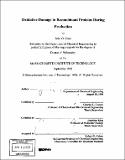Oxidative damage to recombinant proteins during production
Author(s)
Konz, John O. (John Otto), 1971-
DownloadFull printable version (12.23Mb)
Advisor
Charles L. Cooney and Jonathan King.
Terms of use
Metadata
Show full item recordAbstract
Since the introduction of recombinant human insulin nearly two decades ago, recombinant proteins have increasingly been utilized as therapeutic agents. In addition, expression of recombinant proteins is now a common tool used in basic research. Recombinant proteins are subject to many subtle modifications that can affect their properties; among these modifications, oxidative damage is one of the most ubiquitous. Oxidative damage, however, is only occasionally considered as a "quality concern" since it rarely detectable using standard biochemical techniques. The production of an oxidatively-sensitive protein, a1-Antitrypsin, was investigated to ascertain the effect of fermentation parameters on the extent of oxidation. Oxidation of either of two methionine residues in the active site to methionine sulfoxide was sufficient for inactivation, and 50% of the antitrypsin produced under standard fermentation conditions was oxidized. Oxidative damage was linked to the dissolved oxygen concentration by experimentation and detailed modeling of the evolution and detoxification of reactive oxygen species. Under pseudo steady-state conditions, the fractional oxidation is near zero under anaerobic conditions and increases through the microaerobic regime. At dissolved oxygen concentrations greater than 10% of air saturation, the fractional oxidation did not vary. Step changes in the dissolved oxygen concentration, designed to emulate possible time variation resulting from poor mixing or changes in gas composition, caused transient increases in the fractional oxidation and enhanced proteolytic degradation. This may implicate oxidative stress in scale-up related protein quality and quantity limitations. In addition, oxidative damage to antitrypsin caused a 5-fold increase in the stepwise addition rate for in vitro aggregation, which suggests that oxidative damage will limit shelf stability. In addition, process simulation demonstrated that removal of oxidative variants caused a 100% increase in cost per unit when only 22% of the antitrypsin is oxidized during the fermentation step.
Description
Thesis (Ph.D.)--Massachusetts Institute of Technology, Dept. of Chemical Engineering, 1998. Includes bibliographical references (p. 209-222).
Date issued
1998Department
Massachusetts Institute of Technology. Department of Chemical EngineeringPublisher
Massachusetts Institute of Technology
Keywords
Chemical Engineering